Presently, Staten Island has only one passenger rail system, the Staten Island Railroad (SIR) , which runs from St George at the northeastern tip to Tottenville at the southwestern tip. Though it is often referred to as Staten Island Rapid Transit it is in fact a standard gauge railroad by FTA standards (but with third rail power). This means that subway trains would not be able to operate on the line, making it more of a commuter rail.
Like with Brooklyn, rapid transit on Staten Island traces it’s routes back to steam powered trains. Originally there were three branches, the North Shore branch, Main Line (the only surviving line), and the South Beach branch. The North Shore branch ran from Cranford, NJ to St George Terminal and parts are still used today as freight-only service serving the Howland Hook Marine Terminal at the northwestern point of Staten Island. The North Shore branch right-of-way still exists, parts have been turned into a walking path while others remain decaying with the remnants of stations still hanging above the streets. Politicians and planners are currently trying to reactivate the North Shore branch, either as heavy rail like the SIR or as a light rail system.
The South Beach branch split off from the Main Line after Bay St in the Clifton neighborhood and wound its way through Rosebank, Fort Wadsworth, Arrochar, and South Beach, terminating at Wentworth Avenue. Service was discontinued in 1953 and was literally wiped off the map, demapped and redeveloped as housing. Almost nothing remains of the South Beach branch other than a few ghostly markings (e.g. Railroad Ave).
A track schematic from NYCSubway.org showing what the full SIR looked like in 1949.
Like other outer boroughs, Staten Island developed slowly in the 19th and early 20th Century. Originally it served maritime industries, then moving on to light manufacturing and eventually heavy chemicals. The rocky terrain and sandy soil limited farming and many towns developed as seaside resort communities. It wasn’t until after World War II when suburban development began to take hold, in part aided by new automobile-only bridges which the Port Authority of NY and NJ were building. Subways from Brooklyn were planned as early as 1914 but shelved as too costly. The car became king. The Verrazano-Narrows Bridge had been originally planned as a tunnel but when Robert Moses took the project over he built what was at the time the longest suspension bridge in the world. He also criss-crossed the island with highways, though many he wanted to build were stopped.
Still to this day a subway to Staten Island seems like a long shot. The ride alone would be hours long at some points but it would be a one seat ride into Manhattan. The only ways off the island are via clogged bridges or the Staten Island Ferry (which is free). The two options for improved rapid transit on the island being seriously studied are a reactivated North Shore branch (which will not be cheap since the line has been essentially abandoned for 60 years) and connecting the Hudson-Bergen Light Rail system to Port Richmond, either over a new bridge (possibly a replacement for the Bayonne Bridge) or a tunnel under the Kill Van Kull.
The first time I had ever heard of a plan to build a subway to Staten Island the thought which came to me was of a tunnel from downtown under the harbor. I realized that an underwater tunnel over 5 miles long was a ridiculous concept but one which seems to pop into most people’s minds when they also hear of a subway to Staten Island (and one which apparently had been proposed back in the 1950s). Though it would be the most direct route it would also be the most expensive. However, for sake of comparison, I’ll take a good look at a direct tunnel between downtown Manhattan and Staten Island. Also for sake of simplicity, in the map to the right, I have the tunnel connecting to a fully completed Second Ave Subway even though any of the other lines which run through downtown Manhattan could be used instead.
Like I mentioned before, the fastest and shortest way to connect Staten Island to Manhattan would be a tunnel under the harbor. Right away this would be thrown out as a possibility since the Staten Island Ferry makes the exact same trip at a fraction of the cost. One benefit to such a plan would be that Governors Island could be connected to Manhattan with a new station along the line. With new planned development which will occur over the next 20 years there will be an increased need for better transportation to the island. Like for Roosevelt Island it may make more financial sense to build a tram system, such as the one proposed by Santiago Calatrava.
A second alignment, one which would be much less expensive but politically difficult, would build a new tunnel under the Hudson River over to Liberty State Park in New Jersey where the subway would run at grade (thus reducing the cost) along side the existing Hudson-Bergen Light Rail line to Bayonne. New bridges over roads would need to be constructed as the light rail currently crosses the streets at-grade. What makes this tricky is that any transportation infrastructure crossing into New Jersey would be under the jurisdiction of the Port Authority of NY and NJ, making a connection with the MTA would add another layer of bureaucratic red tape. Both alignments would reach Staten Island at the St George ferry terminal. The current SIR is considered by the federal government to be standard rail rather than rapid transit. Because of this subway trains would be prohibited from running on the existing rail.
The more realistic route for building a subway to Staten Island would be under the Narrows between Brooklyn and Staten Island. On the Brooklyn side there already exists the subway infrastructure to connect to so the tunnel wouldn’t have to be as long as if it went directly to downtown Manhattan. Supposedly, when the 4th Ave subway in Brooklyn was being built, a short tunnel was started from Bay Ridge to Staten Island but was never completed since there was no addition funding.
The first option would be to create a branch of the 4th Ave subway (N/R) after 59th St (Brooklyn) which would dive under the harbor and head straight to St George Terminal. This route would follow the path of the extinct 69th St Ferry from Bay Ridge to St George. The original IND Second System plans called for a subway under Bay Ridge Ave. It would be better to built the subway along the Long Island Railroad Bay Ridge branch both for cost and because in doing so it would allow for a 4 track tunnel to be built to allow for freight trains to travel under the harbor, a long standing plan known as the Cross-Harbor Tunnel which has never had the demand to justify the cost (this tunnel has been proposed by the Port Authority since its inception and is still being proposed by planners). Staten Island trains would run express up the 4th Ave line and could enter Manhattan via the Manhattan Bridge or via Whitehall St (tunnel).
An alternative would be to bring back the original IND Second System plan to build a new subway branching off of the Culver (6th Ave) Line at Ft Hamilton Parkway. The 4 track subway would have two branches, one which would serve Dyker Heights (local) and one which would run under the harbor (express) as discussed above. Unlike the 4th Ave alignment, a Ft Hamilton alignment would provide new service to parts of Brooklyn as well as provide express service to Staten Island.
The last alternative would be a variation of the Ft Hamilton subway where instead of the subway terminating in Dyker Heights it would run up on the Verrazano-Narrows Bridge (much like my proposal for a subway on the George Washington Bridge). This alignment would be cheaper than a tunnel as the bridge already exists, though it would have to be retro fitted to allow trains (which Robert Moses famously designed his roads without). This would take away road space from automobiles and cause many delays during construction.
The only “serious” plans I could find of a subway to Staten Island were from the 1939 IND Second System map showing a tunnel under the Narrows to Staten Island with two short branches hugging the coast of the island, one north to St George Terminal and Westervelt Ave, the other south to Grant Ave in Tompkinsville. Having not much to go on I would wonder if these short branches were designed so that one day the North Shore and Main Line branches of the SIR would be converted to subway use. It may be safe to assume this given the history of rapid transit companies and the city converting old railroads into subways.
- North Shore Branch
As I talked about above, the North Shore branch is being tossed around by politicians and planners for reactivation. The most popular ideas for the line would be to rebuild it as heavy rail so trains would use the same rolling stock as the existing SIR or to build it as light rail, which would be cheaper but would prohibit freight trains from using the line. Other ideas are for a bus-way or a commuter bike/walking path. Reactivation, it is hoped, would bring redevelopment to this sleepy corner of the island, something improved bus service would not do.
While reactivating the North Shore branch seems simple enough, it still might face a higher price tag relative to projected ridership. For much of its route the branch hugs the coast, running parallel to Richmond Terrace. There is not much development along this route and it isn’t until you get out to Port Richmond and Mariner’s Harbor when the line runs through built up neighborhoods. The line also ends suddenly in Arlington, past which are rail yards, marshlands, and industrial zones. Because of this I would alter the planned path of the railway by swinging it south when it reaches the Bayonne Bridge to run along the median (or the side) of Route 440, the Dr. Martin Luther King Jr. Expressway, south through Willowbrook Park to a point where Richmond Ave meets Rockland Ave. This routing would serve many more people including parts of western Staten Island which have only developed in the last 50 years. The line might even be extended further south to the Staten Island Mall and the new Fresh Kills Park.
- Hudson-Bergen Light Rail
Another plan floating around is to extend the Hudson-Bergen Light Rail, which currently terminates at East 22nd St in Bayonne, into Staten Island. The Port Authority of NY and NJ is currently looking at ways of dealing with the Bayonne Bridge since new super-sized Post-Panamax container ships have trouble clearing the bridge (dredging only can go so far.) One option is to literally jack the bridge up, but replacements are also being studied. If a new bridge was constructed it could easily have a space for mass transit, a light rail extension or even for express buses (perhaps both). Though no serious plans have surfaced it would seem to be more prudent to keep any extension of the Hudson-Bergen Light Rail short, perhaps a single park-and-ride facility at the toll plaza on the Staten Island side.
- Staten Island Expressway
In keeping with the suburban nature of Staten Island it might make sense to build a subway, elevated or at grade, along the median of the Staten Island Expressway. This alignment would be a continuation of the aforementioned Ft Hamilton Parkway subway which would cross over the Verrazano-Narrows Bridge. Running closer to the geographic center of the island the line could be built with stations farther apart with large parking garages to attract drivers. A major downside would be that this line would not serve the St George Ferry Terminal, the largest transportation hub on the island.
- North-Central Alignments
When proposals for subways on Staten Island come up (now and then), one idea that usually floats to the surface is a subway along Victory Blvd. Victory is the major east-west road crossing the entire north side of the island. If the North Shore branch was reactivated then a subway along Victory Blvd would sit between the two branches of the SIR, serving the island in a nice, geographically proportional way. However, the population of the island is not distributed in such a simple way and Victory Blvd runs though some lightly settle areas (relatively speaking). A better alignment would be one slightly north along Forest Ave or Castleton Ave through West Brighton. These alignments would more directly serve developed areas and commercial strips. These north-central alignments would run west to Jewett Ave and turn south to meet up with Victory Blvd. If there is to ever be an actual subway on Staten Island (and voters like to say, “no”, there won’t) then these are the three most optimum places for one to run.
If I was to create a list of the many, many proposals I’ve discussed throughout this series, which would rank the actual likelihood of a subway being built, a Staten Island subway might be last on the list (excluding a reactivated North Shore Branch which might be at the top). However, no list of proposed subways throughout New York City would be complete with out mentioning Staten Island. The density required for such an expensive project does not exists, nor do the traffic patterns justify building a train line which would take as long as it would to make the journey to Manhattan (the ferry takes about 25-30 min, a train would take a good hour or more).
At the same time the island does need more connections to the world since it only has 4 bridges, most of which are outdated and clogged. A railroad tunnel to Staten Island, be it a subway or part of a Cross-Harbor Freight system, would give island residents another route off in case of emergencies (or another way for supplies to come in). It would also take pressure off New Jersey and Brooklyn highways with other commuting options other than by car.
The most interesting case for a subway to Staten Island is from the Peak Oil debate, that being what will happen when oil prices become so high that the suburban, autocentric lifestyle of the island becomes untenable. The only way off the island is by a machine that uses oil (car, truck, bus, ferry). A train to the rest of the country, now a rather pricey endeavor, might be the more affordable option not too far long down the road.

The futureNYCSubway
- IND Second System
- Post War Expansion
- The Second Ave Subway: History
- The Second Ave Subway: To The Bronx and the Nassau Line
- Brooklyn: Bushwick Trunk Line
- Manhattan: West Side and Hudson Crossings
- Queens: Flushing Trunk Line
- Staten Island: The Last Frontier
- TriboroRX and Atlantic Ave Super-Express
- Conclusion: the vanshnookenraggen plan

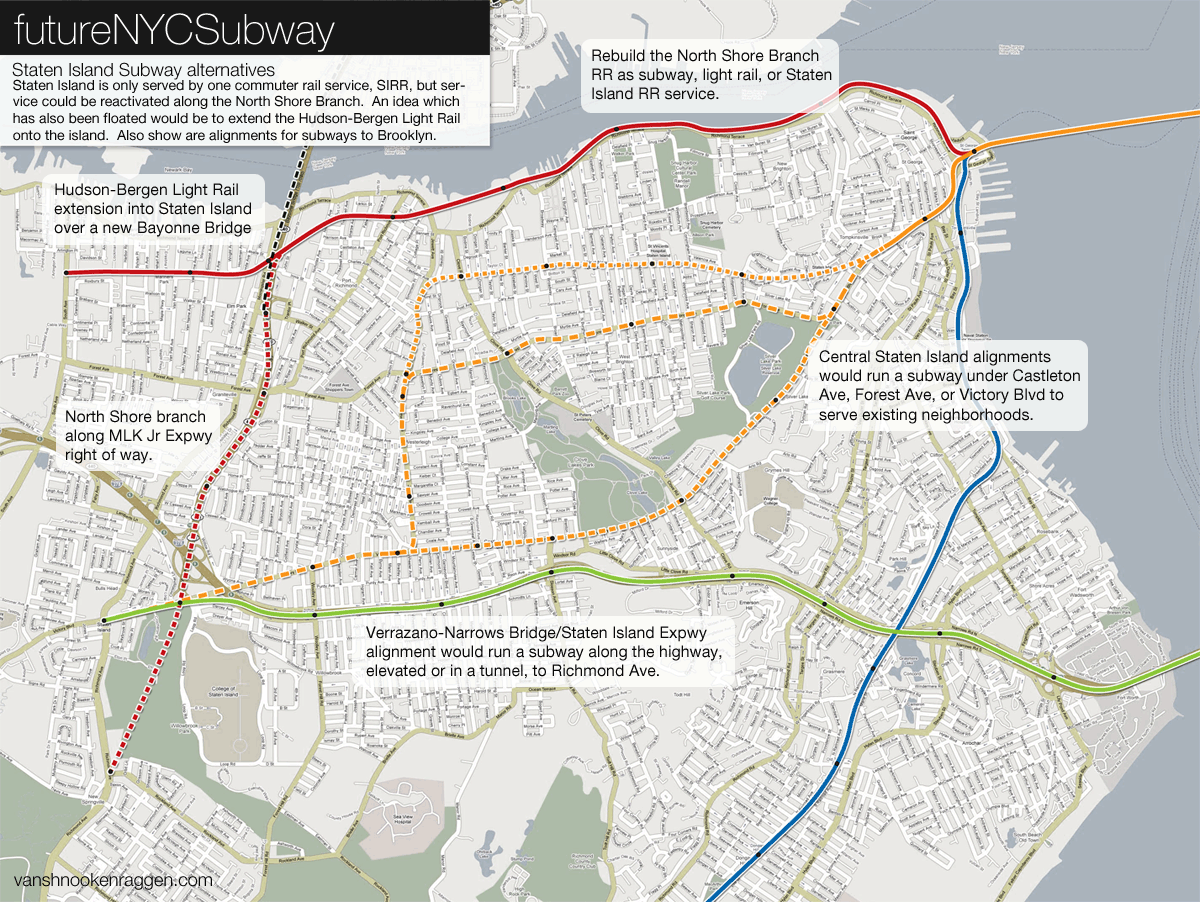
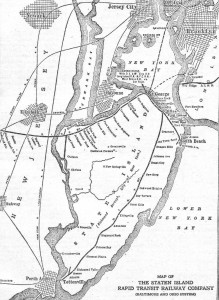

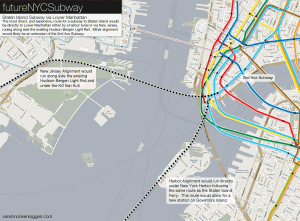
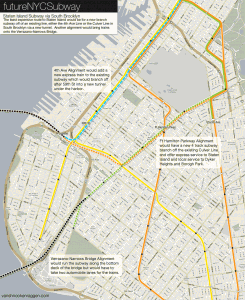
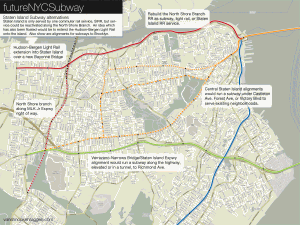
While the Staten Island Railway is technically an FRA-regulated railroad, it has a waiver from the FRA that allows it to run ordinary R44 subway cars with minor modifications. (PATH has a similar arrangement.) As the SIR has not seen a freight train in years (aside from the far west end of the north shore branch) the FRA would almost certainly permit through-routing of subway trains/transfer of the line to FTA rules if a connection were built.
The Bayonne bridge as it currently exists actually has space for either two additional road lanes or a two-track rail line, so the HBLR could be extended over it (“jacked-up” or not) without a new bridge.
While a direct Staten Island-Manhattan tunnel would be expensive, I think you underestimate the extent to which it would be and improvement over the ferry. A direct train could make it from St George to Manhattan in 7 minutes or less, and could run much more frequently than the ferry. Staten Island currently has the longest commute times in the nation. A direct rail tunnel would give it a link to Manhattan comparable to that enjoyed by the other boroughs, which would revolutionize development there. Such a tunnel probably makes most sense in the context of an RER-like super-express/regional rail system as proposed at http://www.thetransportpolitic.com/2010/03/10/new-york-regional-rail-a-coda/ to allow fast access to midtown and other parts of the region, but even a fast subway-based link to downtown would be a huge benefit for Staten Island.
The best option for Staten Island is a mentioned above is a direct underwater subway tunnel to Manhattan via the 2nd ave line. Further more an extension on the Ft. Hamilton Pkwy line via the Verrazano Bridge will be of good use to connect Brooklyn and Staten Island.
I think the best proposal to Staten Island is the 1939 proposal with a line branching off the Culver line. I think that would be easier and cheaper to build a tunnel from Brooklyn than the tunnel from Manhattan.
Although the Manhattan-Staten Island Tube sounds more costly, I for sure know it’s the best option for the City of NY. Did you know that South Korea is currently building the longest underwater tube for high speed rail. This is America and NYC is the capital of the world. We as Americans and New Yorkers should have no excuse. We as a people need to think big. 30 to 50 years from now NYC will have roughly 10 to mabey 18 million. We need transportation alternatives that are going to move people from place to place at a faster pace!!!
I don’t think any train will be able to utilize the Verrazano Narrows Bridge. The bridge’s approach is too steep. Robert Moses did it on purpose. To prevent any future rail serivce from using his bridge. So any possible extension cross the bridge would be impratical and even if the train makes it up there the bridge was never built to handle heavy rail traffic so you would have severe problems with oscillation.
Beyond Arligton, the North Shore Railway once had a stop at Howland Hook (its official name was Milliken at first, later Port Ivory), which was closed a few years before passenger service on the line as a whole was stopped in 1953; then the line continues on across its own bridge parallel to the Goethals Bridge into New Jersey, where it proceeds to Cranford Junction, with stops such as Roselle Park along the way. Furthermore, a West Shore spur branches off from the main line between Arlington and Howland Hook, and proceeds all the way down to Victory Blvd. in Travis; conceivably, this could be extended to meet the present SIR near its present Nassau station.
I was wondering the program you used for the maps with your recommendations for Staten Island subway lines.
I combined Google Maps in Photoshop and drew the subway lines in Illustrator, then imported them into Photoshop and added the extra stuff.
Like Anthony Brancato’s idea of taking the North Shore RR to Howland Hook and then cross the bridge parallel to the Goethals Bridge into New Jersey, it can go north along New Jersey Turnpike and go to Newark Libetry International Airport.
You don’t build for the density you have, you build for the density you want to see (and in tandem work to ensure the zoning laws are moved to support it). Just look at Queens and Brooklyn.
This city needs to create almost a million housing units in short order if we’re going to keep up with projected population increases AND make a dent in the overly-expensive median prices. Staten Island is a good place to meet some of this work.
Not to mention that the only way on and off the island (in any major way) is via car/bus. At some point the bridges just won’t be able to handle the growth and ferries will only go so far. Even a connection to NJT via Bayone or Newark will be a good option (not the best but whatever).
I had an idea of creating subway lines based on the previous proposals as far back as the 1900s but, as I was told by by my classmate who also lives in Staten Island,the tectonic plates under Staten Island makes it difficult to build subways underground. so building a line along the Staten Island Expressway would leave you with only two options. either an el or a trench. the main line and the north shore branch of the SIR will remain unchanged since they’re both outside. building subway lines along the main roads in Staten Island would be difficult such as victory Blvd and Forest avenue
I have been reading about the Montreal Metro and how they were able to cut costs by using one large tunnel for two sets of tracks. I think an new rail line from the Fulton Transit Center in downtown Manhattan to Staten Island vis Governors Island, Red hook and a stop in western Brooklyn would be the best plan. By having a Montreal (or Paris) style rubber wheel subway, tunneled at about $150 million per km (the present cost being expended for the Laval extension) you could not only tunnel under the bay but build a subway down either Victory or Forest Avenues. Converting the SIRT and the North Shore line to the same subway car type you could have all the lines terminate at the Fulton Transit Center. Then any extension (be it West Shore, MLK xway, Richmond Ave ect) could be above ground since the rubber wheels produce little noise.
Now that Mayor Bloomberg is trying to get the $10 billion the Governor Christie gave up on the NJ Transit extension into Penn Station, some of those funds should be used to give the county with the longest commuter travel time a new transit system.
Any new subway would have to be compatible with existing rolling stock otherwise any savings would be eaten up by needing to build an entire new infrastructure.
So glad i found this site. Excellent resource, and very well organized. I believe if there was a tunnel from St. George to Manhattan, the entire dynamic of the boro would change (for the better). Staten Island would become a seriously attractive boro with enough space to satisfy residents and developers. Trains to Bay Ridge would be great too.